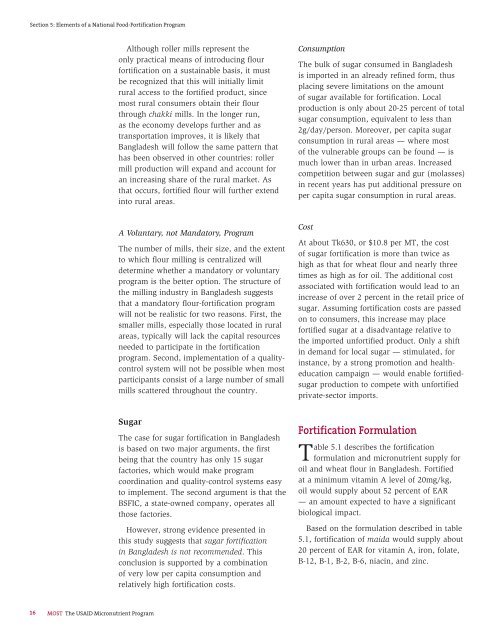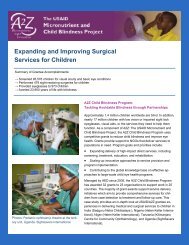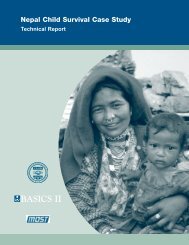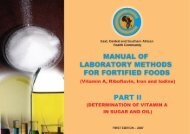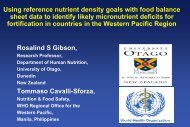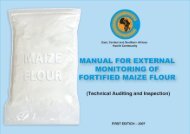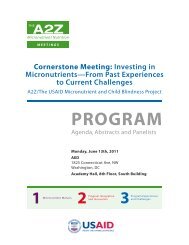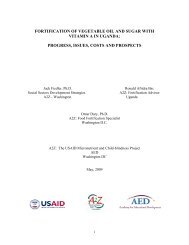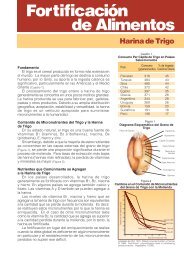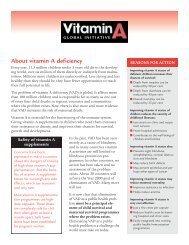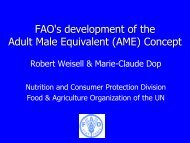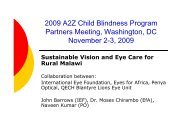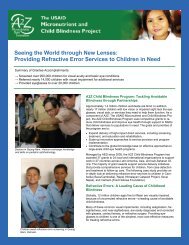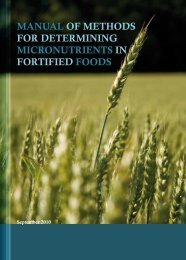Elements of a National Food- Fortification Program for Bangladesh
Elements of a National Food- Fortification Program for Bangladesh
Elements of a National Food- Fortification Program for Bangladesh
Create successful ePaper yourself
Turn your PDF publications into a flip-book with our unique Google optimized e-Paper software.
Section 5: <strong>Elements</strong> <strong>of</strong> a <strong>National</strong> <strong>Food</strong>-<strong>Fortification</strong> <strong>Program</strong>Although roller mills represent theonly practical means <strong>of</strong> introducing flour<strong>for</strong>tification on a sustainable basis, it mustbe recognized that this will initially limitrural access to the <strong>for</strong>tified product, sincemost rural consumers obtain their flourthrough chakki mills. In the longer run,as the economy develops further and astransportation improves, it is likely that<strong>Bangladesh</strong> will follow the same pattern thathas been observed in other countries: rollermill production will expand and account <strong>for</strong>an increasing share <strong>of</strong> the rural market. Asthat occurs, <strong>for</strong>tified flour will further extendinto rural areas.ConsumptionThe bulk <strong>of</strong> sugar consumed in <strong>Bangladesh</strong>is imported in an already refined <strong>for</strong>m, thusplacing severe limitations on the amount<strong>of</strong> sugar available <strong>for</strong> <strong>for</strong>tification. Localproduction is only about 20-25 percent <strong>of</strong> totalsugar consumption, equivalent to less than2g/day/person. Moreover, per capita sugarconsumption in rural areas — where most<strong>of</strong> the vulnerable groups can be found — ismuch lower than in urban areas. Increasedcompetition between sugar and gur (molasses)in recent years has put additional pressure onper capita sugar consumption in rural areas.A Voluntary, not Mandatory, <strong>Program</strong>The number <strong>of</strong> mills, their size, and the extentto which flour milling is centralized willdetermine whether a mandatory or voluntaryprogram is the better option. The structure <strong>of</strong>the milling industry in <strong>Bangladesh</strong> suggeststhat a mandatory flour-<strong>for</strong>tification programwill not be realistic <strong>for</strong> two reasons. First, thesmaller mills, especially those located in ruralareas, typically will lack the capital resourcesneeded to participate in the <strong>for</strong>tificationprogram. Second, implementation <strong>of</strong> a qualitycontrolsystem will not be possible when mostparticipants consist <strong>of</strong> a large number <strong>of</strong> smallmills scattered throughout the country.CostAt about Tk630, or $10.8 per MT, the cost<strong>of</strong> sugar <strong>for</strong>tification is more than twice ashigh as that <strong>for</strong> wheat flour and nearly threetimes as high as <strong>for</strong> oil. The additional costassociated with <strong>for</strong>tification would lead to anincrease <strong>of</strong> over 2 percent in the retail price <strong>of</strong>sugar. Assuming <strong>for</strong>tification costs are passedon to consumers, this increase may place<strong>for</strong>tified sugar at a disadvantage relative tothe imported un<strong>for</strong>tified product. Only a shiftin demand <strong>for</strong> local sugar — stimulated, <strong>for</strong>instance, by a strong promotion and healtheducationcampaign — would enable <strong>for</strong>tifiedsugarproduction to compete with un<strong>for</strong>tifiedprivate-sector imports.SugarThe case <strong>for</strong> sugar <strong>for</strong>tification in <strong>Bangladesh</strong>is based on two major arguments, the firstbeing that the country has only 15 sugarfactories, which would make programcoordination and quality-control systems easyto implement. The second argument is that theBSFIC, a state-owned company, operates allthose factories.However, strong evidence presented inthis study suggests that sugar <strong>for</strong>tificationin <strong>Bangladesh</strong> is not recommended. Thisconclusion is supported by a combination<strong>of</strong> very low per capita consumption andrelatively high <strong>for</strong>tification costs.<strong>Fortification</strong> FormulationTable 5.1 describes the <strong>for</strong>tification<strong>for</strong>mulation and micronutrient supply <strong>for</strong>oil and wheat flour in <strong>Bangladesh</strong>. Fortifiedat a minimum vitamin A level <strong>of</strong> 20mg/kg,oil would supply about 52 percent <strong>of</strong> EAR— an amount expected to have a significantbiological impact.Based on the <strong>for</strong>mulation described in table5.1, <strong>for</strong>tification <strong>of</strong> maida would supply about20 percent <strong>of</strong> EAR <strong>for</strong> vitamin A, iron, folate,B-12, B-1, B-2, B-6, niacin, and zinc.16MOST The USAID Micronutrient <strong>Program</strong>


